The Autumn Pincer Movement
West Coast of Sweden, north of Gotenburg
by Sarah Shuckburgh
October in Sweden is lobster
season. Sarah Shuckburgh embarks on a seafood safari.
 In
autumn, the west coast of Sweden is the place for a
gastronomic treat. The first Monday after September 20th
marks the start of the lobster season, and my daughter
Hannah and I have come on a lobster safari. In
autumn, the west coast of Sweden is the place for a
gastronomic treat. The first Monday after September 20th
marks the start of the lobster season, and my daughter
Hannah and I have come on a lobster safari.
The coastline between Gothenburg and the Norwegian border is
scattered with ten thousand rocky islands, lapped by
glittering, steel-grey bays. Most of the Bohuslän
archipelago is
 uninhabited but traditional fishing villages
still survive. According to locals, this is the home of the
world’s tastiest seafood - lobsters and langoustines,
scallops and mussels, oysters and herrings, succulent and
slow-growing in the chilly Skagerrak waters. uninhabited but traditional fishing villages
still survive. According to locals, this is the home of the
world’s tastiest seafood - lobsters and langoustines,
scallops and mussels, oysters and herrings, succulent and
slow-growing in the chilly Skagerrak waters.
Gothenburg City airport is pleasingly rural, and moments
after landing, Hannah and I are cruising in our golden
rented Volvo through sedate Friday afternoon traffic. Almost
everyone here drives a Volvo, manufactured on the nearby
island of Hisingen across the Göta river. The countryside
gleams in autumnal sunshine – a peaceful, undulating
landscape of woods, fields and meadows of shaggy-coated
cattle. White clapboard churches and brightly-coloured
wooden houses nestle beneath grey, rocky escarpments.
Leaving the mainland, we drive over gracefully-arched
bridges, take a ferry (free of charge) across a strait, and,
as the bridges become smaller and lower, we reach the remote
island of Flatön.
 Our hotel, the Handelsman Flink, is a cluster of yellow
toy-town houses overlooking a shimmering fjord. Our room is spartan but warm, with nautical motifs on every surface to
remind us of the purpose of our visit. Before supper, we
have time for a blustery walk along the shingle beach,
across a marshy meadow and out along a rickety jetty. From
here we stare at limitless expanses of water and sky. The
estuary glitters like polished silver beneath the pink and
grey sunset. Across the bay loom the rounded shapes of
dozens more islands, some wooded, some treeless. Hannah and
I stop chattering and try to tune our jostling, urban minds
to the emptiness of this extraordinary place. Our hotel, the Handelsman Flink, is a cluster of yellow
toy-town houses overlooking a shimmering fjord. Our room is spartan but warm, with nautical motifs on every surface to
remind us of the purpose of our visit. Before supper, we
have time for a blustery walk along the shingle beach,
across a marshy meadow and out along a rickety jetty. From
here we stare at limitless expanses of water and sky. The
estuary glitters like polished silver beneath the pink and
grey sunset. Across the bay loom the rounded shapes of
dozens more islands, some wooded, some treeless. Hannah and
I stop chattering and try to tune our jostling, urban minds
to the emptiness of this extraordinary place.
Supper – and every meal at the family-run hotel - is
accompanied by a tape of jolly music, and we notice that
other guests know the words and are singing along. Our host,
Stefan Hjelmér, explains that Evert Taune, a celebrated
Swedish composer and
 troubadour, spent many summers on these
islands and wrote songs about them. Everyone’s favourite is
the eponymous Handelsman Flink – the ‘hard-working
shopkeeper’, who was apparently famously lazy. His shop
still exists, next door to the hotel, now stocked with
vintage memorabilia and souvenirs. troubadour, spent many summers on these
islands and wrote songs about them. Everyone’s favourite is
the eponymous Handelsman Flink – the ‘hard-working
shopkeeper’, who was apparently famously lazy. His shop
still exists, next door to the hotel, now stocked with
vintage memorabilia and souvenirs.
Tucked up that night in our nautical bunks, we watch a
television programme alarmingly entitled Deep Sea Fishing,
the World’s Most Dangerous Profession. Later, I dream of
giant lobsters, grabbing me with enormous claws.
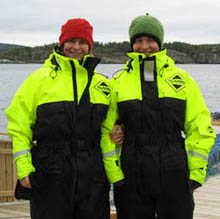
Next morning, after a smörgåsbord breakfast, we borrow
bicycles and explore the island, struggling against the wind
up small inclines and free-wheeling down again. Rain during
the night has made the landscape extraordinarily colourful -
the tufty meadows luminous green, the heather unnaturally
purple, the beaches almost black, the granite rocks striped
with pink, the water blindingly bright. We pedal past
shuttered wooden houses, painted red, ochre or white. The
verges are dotted with scarlet hips and haws, and yellow sea
buckthorn. Pausing on a low bridge above a sun-speckled
inlet, we watch gulls perching on russet-painted boats.
 After a delicious lunch of frothy fish soup, it is time for
our safari. Nervously donning extra jerseys, woolly hats and
gloves, and wriggling into fluorescent boiler-suits with
built-in life jackets, we waddle to the boat and clamber in.
Niclas, our skipper – handsome but taciturn son-in-law of
the hotelier - looks cool in designer jeans and jersey. After a delicious lunch of frothy fish soup, it is time for
our safari. Nervously donning extra jerseys, woolly hats and
gloves, and wriggling into fluorescent boiler-suits with
built-in life jackets, we waddle to the boat and clamber in.
Niclas, our skipper – handsome but taciturn son-in-law of
the hotelier - looks cool in designer jeans and jersey.
Our vessel speeds across the estuary, weaving between barren
islands of rounded grey rock, uninhabited except for an
occasional lone wooden hut or lighth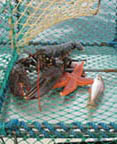 ouse. Soon we are
lurching out to sea, past clusters of yellow saucers which
turn waves into electricity. The wind is bitterly cold, and
icy spray lashes at our cheeks. Hannah and I fasten our
fluorescent hoods so that only our eyes show, and wonder in
shouted whispers why we have come. ouse. Soon we are
lurching out to sea, past clusters of yellow saucers which
turn waves into electricity. The wind is bitterly cold, and
icy spray lashes at our cheeks. Hannah and I fasten our
fluorescent hoods so that only our eyes show, and wonder in
shouted whispers why we have come.
But now and then the boat slows and we lean over the side,
wielding a heavy hooked pole and struggling to catch a
bobbing buoy and heave it on board. Then, gloves soaked with
salt water, we haul 30 yards of rope, which becomes heavier
and heavier and more festooned with weed, until a cumbersome
wire cage emerges from the waves.
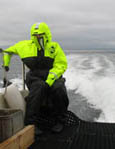
Most lobster pots contain only a stray starfish or crab, but
on my third attempt, a blue-black lobster cowers inside the
netting. One claw is missing, but it is still an impressive
sight. Niclas shows me how to hold its thrashing body,
avoiding the lone pincer, and then how to measure it, from
eye to rump.
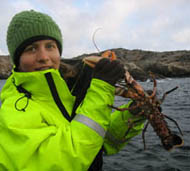
Hannah pulls in several lobsters, including one with
black caviar clustered to its belly. The females carry the
roe under their shells, but move the eggs outside for the
last two months before releasing them into the sea. It is
illegal to take females with eggs but we put the lobster
back in the cage, a practice which Niclas says is done in
Maine, to entice males to the trap.
The term ‘safari’ is a stretch of terminology. I had
imagined that we would be joining a real fishing boat with
genuine fishermen, but despite the discomfort and cold, this
is a tourist outing. Niclas is a fisherman, but is also the
hotel chef. After lifting one lobster pot, we roar on to
another site, bouncing over the choppy seas, freezing waves
splashing over our waterproof suits. There are no seats, and
the deck slopes menacingly towards the foaming
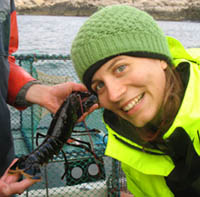 wake, with no
railing. Hannah and I slither about, clutching the black
rubber matting to stop our descent into the icy depths. wake, with no
railing. Hannah and I slither about, clutching the black
rubber matting to stop our descent into the icy depths.
At a chilly but picturesque village with waterways instead
of roads, and houses perched on stilts, we remove our sodden
gloves to guzzle ‘fika’ – sugar-topped cinnamon buns and
coffee. Then, as the sun touches the sea, we chug back to
the hotel jetty. Now Niclas puts us to work in a whitewashed
kitchen by the quay, plunging lobsters into a vat of boiling
beer and water, flavoured with sugar and dill. After eleven
minutes, we hook the corpses out, now turned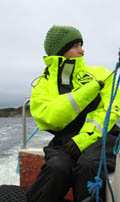 from blue-black
to shiny red, and perform tricky surgery, hacking shells,
pulling claws, tweaking out meat. After we have mangled our
catch, Niclas suggests that we relax in the sauna while he
prepares a feast. At the end of the jetty, a hot tub steams
invitingly, but we opt for an indoor Jacuzzi and sauna,
where we strip off and sluice ourselves with ladles. By
suppertime, Niclas has turned our clumsily-dismembered catch
into an outstandingly delicious lobster meal. from blue-black
to shiny red, and perform tricky surgery, hacking shells,
pulling claws, tweaking out meat. After we have mangled our
catch, Niclas suggests that we relax in the sauna while he
prepares a feast. At the end of the jetty, a hot tub steams
invitingly, but we opt for an indoor Jacuzzi and sauna,
where we strip off and sluice ourselves with ladles. By
suppertime, Niclas has turned our clumsily-dismembered catch
into an outstandingly delicious lobster meal.
We have caught our own black-gold of the ocean. What next?
Hannah is full of ideas for gastronomic hunting along
Sweden’s west coast. “Elk are culled at this time of year.
They grow as big as elephants”, she says. “And next April –
you get underwater binoculars and a net – let’s go on an
oyster safari”.
First published by the Telegraph
©SarahShuckburgh |